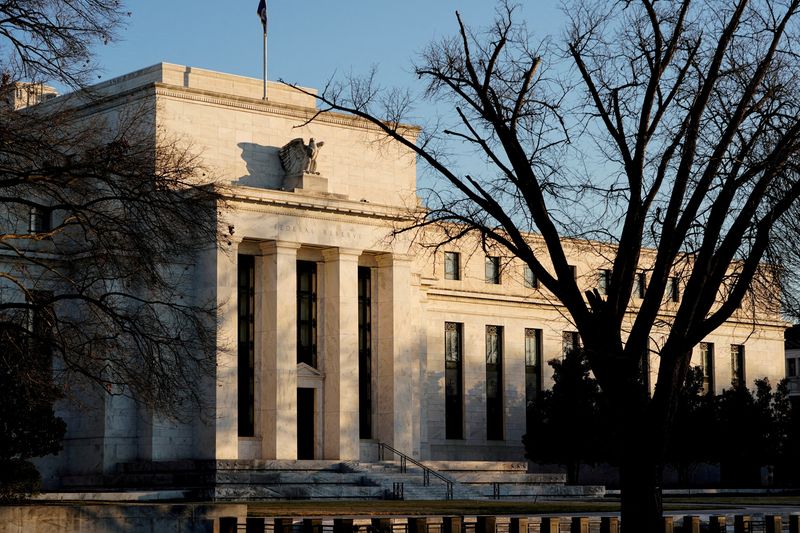By Ann Saphir
(Reuters) - The labels "dove" and "hawk" have long been used by central bank watchers to describe the monetary policy leanings of policymakers, with a dove more focused on risks to the labor market and a hawk more focused on the threat of inflation.
The topsy-turvy economic environment of the coronavirus pandemic sidelined those differences, turning U.S. Federal Reserve officials at first universally dovish as they sought to provide massive accommodation for a cratering economy, and then, when inflation surged, into hawks who uniformly backed aggressive interest rate hikes. Now, as Fed policymakers note improvement on inflation and some cooling in the labor market but also stronger-than-expected economic growth, divisions are more evident, and the choices more varied: to raise rates again, skip for now but stay poised for more later, or take an extended pause.
All 12 regional Fed presidents discuss and debate monetary policy at Federal Open Market Committee (FOMC) meetings that are held eight times a year, but only five cast votes at any given meeting, including the New York Fed president and four others who vote for one year at a time on a rotating schedule.
The following chart offers a look at how officials currently stack up on their outlooks for Fed policy and how to balance their goals of stable prices and full employment. The designations are based on comments and published remarks; for more on the thinking that shaped these hawk-dove designations, click on the photos in this graphic.
Reuters over time has shifted policymaker designations based on fresh comments and developing circumstances - for an accounting of how our counts have changed please scroll to the bottom of this story.
Dove Dovish Centrist Hawkish Hawk
Patrick John Jerome Michelle
Harker, Williams, New Powell, Bowman,
Philadelph York Fed Fed Governor,
ia Fed President, Chair, permanent
President, permanent permanent voter: "My
2023 voter: "We voter: baseline
voter: "A are at, or "If it economic
decrease near, the becomes outlook
in the peak level of appropria continues
policy the target te to to expect
rate is range of the tighten that we
not federal funds policy will need
something rate." Nov further, to
that is 30, 2023 we will increase
likely to not the
happen in hesitate federal
the short to do funds rate
term." so." Nov. further."
Nov. 8, 9, 2023 Nov. 28,
2023 2023
Raphael Philip Christoph Loretta
Bostic, Jefferson, er Mester,
Atlanta Vice Chair: Waller, Cleveland
Fed "We are in a Governor, Fed
President, sensitive permanent President,
2024 period of voter: "I 2024
voter: "I risk am voter:
don’t management, increasin "Monetary
think where we have gly policy is
we’ve seen to balance confident in a good
the full the risk of that place for
effects of not having policy is policymake
restrictiv tightened currently rs to
e policy." enough, well assess
Nov. 29, against the positione incoming
2023 risk of d to slow informatio
policy being the n on the
too economy economy
restrictive.” and get and
Oct. 9, 2023 inflation financial
back to conditions
2%." Nov. ." Nov.
28, 2023 29, 2023
Michael Barr, Neel
Vice Chair of Kashkari,
Supervision, Minneapol
permanent is Fed
voter: The President
Fed is "at or , 2023
near the voter:
peak" of "When
interest activity
rates.” Nov. continues
17, 2023 to run
this hot,
that
makes me
question
if policy
is as
tight as
we assume
it
currently
is." Nov.
7, 2023
Lisa Cook, Lorie
Governor, Logan,
permanent Dallas
voter: "I Fed
see risks as President
two-sided, , 2023
requiring us voter:
to balance "We have
the risk of seen some
not retraceme
tightening nt in
enough that
against the 10-year
risk of yield and
tightening financial
too much." condition
Nov. 16, 2023 s, and so
I'll be
watching
to see
whether
that
continues
and what
that
means for
the
implicati
ons of
policy,"
Nov. 7,
2023
Austan Goolsb Thomas
ee, Chicago Barkin,
Fed Richmond
President, Fed
2023 voter: President
"If we hit , 2024
the targets voter:
that we "If
expect to inflation
hit, then we is going
would be on to flare
path to get back up,
to 2%, and I think
that's what I you want
call the to have
golden path." the
Nov. 17, 2023 option of
doing
more on
rates."
Nov. 29,
2023
Mary Daly,
San Francisco
Fed
President,
2024 voter:
"I'm thinking
about whether
we have
enough
tightening in
the system
and are
sufficiently
restrictive
to restore
price
stability.
Discussions
about
interest rate
cuts are not
particularly
helpful at
the moment."
Nov. 30, 2023
Susan
Collins,
Boston Fed
President,
2025 voter:
The Fed
should be
"patient and
resolute, and
I wouldn't
take
additional
firming off
the table."
Nov. 17, 2023
Note: Fed policymakers began raising interest rates in March 2022 to bring down high inflation. Their most recent policy rate hike, to a range of 5.25%-5.50%, was in July.
Most policymakers as of September expected one more rate hike by the end of this year, but recently many have expressed more confidence that none will be needed. Neither Jeff Schmid, who has been Kansas City Fed's president since August and will be a voter on the FOMC in 2025, nor Adriana Kugler, a permanent voter who was confirmed to the Fed's Board of Governors in September, have yet made any substantive policy remarks. The St. Louis Fed has begun a search to replace its former president, James Bullard, who took a job in academia; the new chief will be a voter on the policy-setting committee in 2025. Interim St. Louis Fed chief Kathleen O'Neill Paese appears to lean hawkish.
Below is a Reuters count of policymakers in each category, heading into recent Fed meetings.
FOMC Date Dove Dovish Centris Hawkish Hawk
t
Oct/Nov '23 0 2 7 5 2
Sept '23 0 4 3 6 3
June '23 0 3 3 8 3

March '23 0 2 3 10 2
Dec '22 0 4 1 12 2